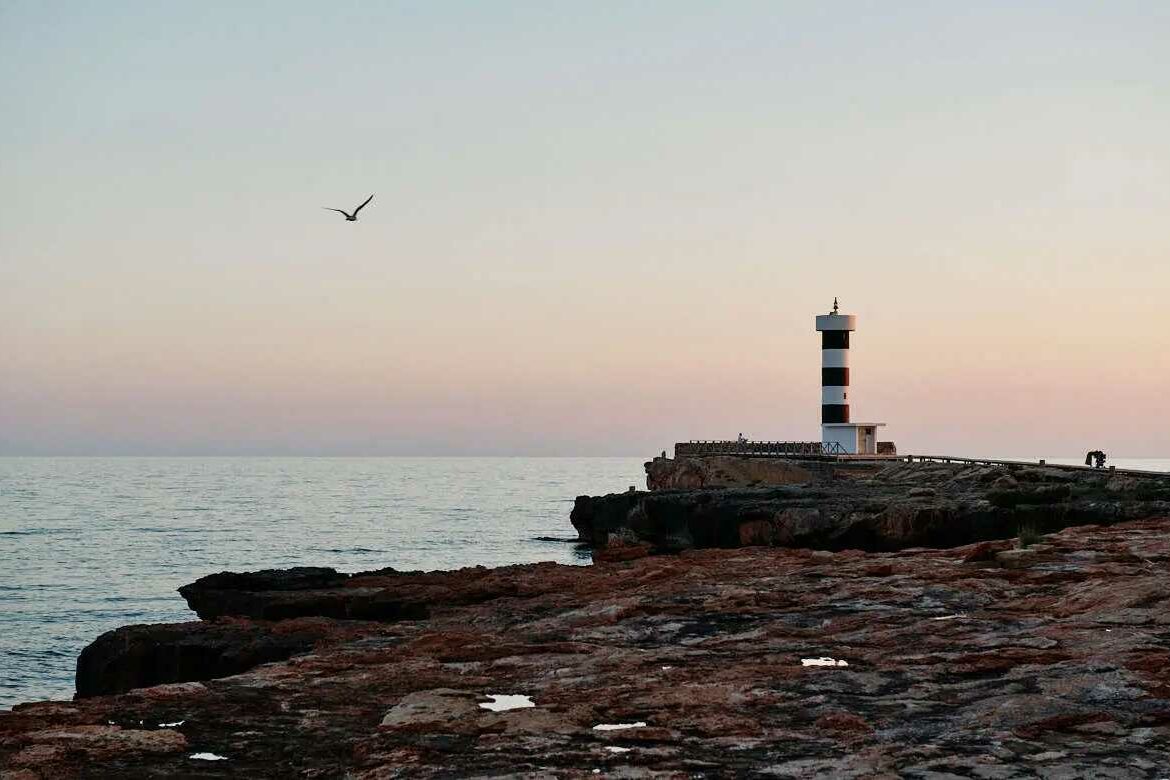Colònia Sant Jordi: the corner of Mallorca where time has stood still.
The traditions of the fishermen persist in a landscape of salt pans, white sandy beaches, and turquoise waters, with secluded coves and lighthouses to discover.
In the southeastern tip of Mallorca, an old fishing village has undergone a radical change in recent decades thanks to tourism. However, the rapid urban expansion has not eradicated the way of life of many fishermen, who continue to catch gigantic tuna as generations before, or the ancient history that emanates from the area’s salt pans.
In Colònia Sant Jordi, one can see this union between past and present with the blocks built for tourism alongside ancient stone houses, in a village where the major gastronomic and commercial offerings are concentrated on the small promenade that houses the marina.
Yet, if someone is looking for time-stopped corners, they can pass through the nearby nuclei of Les Salines (with its beautiful square surrounded by white houses) and Santanyí, where in its weekly market one can catch a more traditional village spirit.
Les Salines and Santanyí are towns that, together with Colònia Sant Jordi, present a different picture of southern Mallorca.

It can also be found in the fishing village of Cala Figuera, hidden among the rocky cliffs covered with pines and fig trees.
The white houses with their green windows and doors give a chromatic touch to remember, and thanks to their absence of beaches, it has been saved from urban bulldozing.
The Cabrera Islands
This area of Mallorca is for coming to encounter nature. For example, excursions to the Cabrera archipelago, a group of 19 islets of stunning beauty, a haven of biodiversity, and home to a large number of small reptiles, seabirds, and mammals, depart from the moorings of Sant Jordi.

However, the great wealth is beneath its turquoise waters, with 500 species of marine fauna, such as gilthead bream, sea bass, groupers, octopuses, sea urchins, turtles, and cuttlefish.
The beaches of Colònia Sant Jordi
The beauty of Cabrera competes with the natural attractions near the colony, such as Es Trenc beach, with its white sands and clear waters that seem to have been transported from the Caribbean.
At 2.5 km, it is the longest in Mallorca, which guarantees solitude a very short distance from the village.
On either side of the small urban nucleus, a string of more beaches and coves unfolds, some of which can only be reached by boat, like the excursions offered by Náutica Colonia company.

One of them is the beautiful and secluded Cala MarmolsCala Marmols, quite challenging to access if one dares to arrive on foot; Es Caragol and its abundant underwater fauna thanks to the great presence of seagrass; Tugores , which allows snorkeling in shallow waters; or Es Carbó with some of the most transparent waters in the area.
Lighthouses and rocks
With the swaying of the boat, the Ses Salines Lighthouse comes into view,a silent guardian of these steep coasts, inaugurated in 1863 at the southernmost point of the island, which can also be reached after an intense five-hour hiking journey along the cliffs from Cap de Ses Salines.

By boat, one also reaches the curious natural formation of Es Pontàs, a rock arch that emerges among the clear waters, and which is one of the most sought-after spots by sunset hunters to post on Instagram.
This whimsical geological feature of nature can also be viewed from the shore, sitting on the benches at the Es Pontàs lookout point.
The salt pans
But undoubtedly one of the most surreal landscapes is Las Salinas de d’Es Trenc. This area, declared a Natural Area of Special Interest, has been producing salt through the evaporation of seawater since Neolithic times.
The exploitation of sea salt dates back to the Neolithic era, and it had already been recognized by
The combination of sun, wind, low humidity, and traditional techniques allows for the production of various types of sea salt, like the 10,000 annual tons produced by the Salinas de Levante company.

It is an artisanal job carried out during the summer months when workers rake the surface layer and pour the product into baskets to remove the water and finish drying under the blazing sun.
It’s a tough job done before dusk to prevent the air’s humidity from dissolving the salt crystals.
The tuna “ronqueo”
Another activity that remains unchanged over time is the “ronqueo” of tuna, the process of cutting and sectioning these gigantic fish.
It is a technique mainly performed between April and May when wild tuna migrate to warmer waters to spawn, and throughout June as they return to the Atlantic Ocean.

From each piece, about 25 edible parts can be extracted, which are prepared in traditional dishes and more sophisticated ones like those offered at the Salicornia restaurant, located on the seafront as part of the Honucai hotel.
There, chef Pablo Tomás (who has worked at Drolma and El Bulli) makes an interesting reinterpretation of traditional Mallorcan dishes, offered in a space decorated as an extension of the sea.

It’s the same aesthetic as the Honucai, a boutique hotel with 78 rooms that is one of the few that, in addition to services like its solarium, meeting rooms, and its sophisticated terrace The Top, has everything prepared to welcome cyclists and offer everything from a repair workshop to washing areas.
And if you’re eager to go cycling but don’t have a bike, no worries: here you can rent one and let yourself discover new landscapes of southern Mallorca.
https://www.economiadigital.es/tendenciashoy/viajeros/destinos/mallorca-colonia-sant-jordi.html



